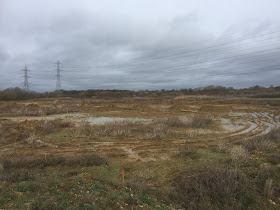Did a morning on the farmlands today. Despite the cold snap at the moment nothing was moving really. Waxwings have got as far south as Balham in our area so we are keeping an eye out for them.
17 Meadow Pipit, 2 Skylark and 2-3 Stonechat on the Southern Mound with good numbers of Starlings and Corvids feeding on the recently mowed meadow was encouraging to see that this habitat is supporting wintering bird populations. At least four Cetti's Watrblers and 5 Water Rail calling around the edge of the lakes. 39 Pochard on the lakes was a relatively good count. Otherwise pretty quiet- the gull numbers seems to be getting even lower and a Viridor contractor mentioned that tipping had completely finished now so we should expect to see even less gulls- it was good that we got our last Glaucous and Iceland Gulls in this winter. Only one Caspian Gull sighting so far this year- could well be a mega locally in the near future.
There was a lot of Viridor activity on site today with a group of top cats walking around and certainly more activity on the Wet Grassland area. Not holding our breath but there might actually be some progress being made with the restoration.
Starling- don't always get them this tame- maybe struggling a bit in the cold snap
39 Pochard today- a pretty good count
Teal were out on the ice- presumably some of the beds on 100 acre have frozen over
One of several Stonechats (6-8 across the site)




















































